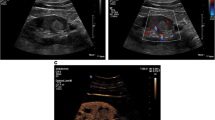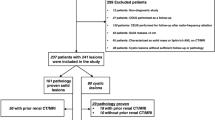Abstract
Background
This is a study using Evidence Based Practice (EBP) technique to evaluate if non-calcified renal lesions detected with ultrasound, suspected to represent an angiomyolipoma (AML), need a CT to rule out a renal cell carcinoma (RCC).
Methods
The secondary and primary literature were searched for all relevant information. This was appraised for validity and strength. The results from the papers with the highest level of evidence were grouped together and analyzed.
Results
Three papers in the primary literature constituted the highest level of evidence. In total these three papers examined 220 lesions. The prevalence of AML was 45% in this sample. Overall, hyperechoic non-calcified renal lesions had a sensitivity of 0.99 (95% confidence interval (CI) 0.97–1.00), a specificity of 0.43 (95% CI 0.34–0.51), a positive predictive value (PPV) of 0.58 and a negative predictive value (NPV) of 0.98 for AMLs. 57.4% of RCCs were hyperechoic to renal parenchyma. Two of the studies found that posterior acoustic shadowing had a sensitivity of 0.34 (95% CI 0.40–0.56) and a specificity of 1.0 (95% CI 1.0–1.0) for AML.
Conclusions
From the surprisingly limited evidence available in the literature, it must be concluded that all non-calcified echogenic renal lesions detected with ultrasound need a CT to rule out an RCC.


Similar content being viewed by others
References
Staunton M (2007) Evidence-based radiology: Steps 1 and 2—asking answerable questions and searching for evidence. Radiology 242(1):23–31
Dodd JD (2007) Evidence-based practice in radiology: Steps 3 and 4—appraise and apply diagnostic radiology literature. Radiology 242(2):342–354
Mindell HJ (1996) Do all homogeneously echogenic renal lesions that are smaller than 1.5 cm and are seen incidentally on sonograms (lesions presumed to be angiomyolipomas) require CT to confirm fat content of such lesions? AJR Am J Roentgenol 167(6):1590
Siegel CL, Middleton WD, Teefey SA, McClennan BL (1996) Angiomyolipoma and renal cell carcinoma: US differentiation. Radiology 198:789–793
Zebedin D, Kammerhuber F, Uggowitzer MM, Szolar DH (1998) Criteria for ultrasound differentiation of small angiomyolipomas (< or = 3 cm) and renal cell carcinomas. Rofo 169(6):627–632
Yamashita Y, Ueno S, Makita O, et al. (1993) Hyperehoic renal tumors: anechoic rim and intratumoral cysts in US differentiation of renal cell carcinoma from angiomyolipoma. Radiology 188:179–182
MacEneaney PM, Malone DE (2000) The meaning of diagnostic test results: a spreadsheet for swift data analysis. Clin Radiol 55:227–235
Mouraviev V, Joniau S, Van Poppel H, Polascik TJ (2007) Current status of minimally invasive ablative techniques in the treatment of small renal tumours. Eur Urol 51(2):328–336
Author information
Authors and Affiliations
Corresponding author
Rights and permissions
About this article
Cite this article
Farrelly, C., Delaney, H., McDermott, R. et al. Do all non-calcified echogenic renal lesions found on ultrasound need further evaluation with CT?. Abdom Imaging 33, 44–47 (2008). https://doi.org/10.1007/s00261-007-9306-1
Published:
Issue Date:
DOI: https://doi.org/10.1007/s00261-007-9306-1




